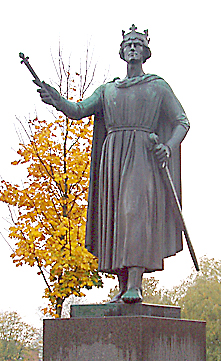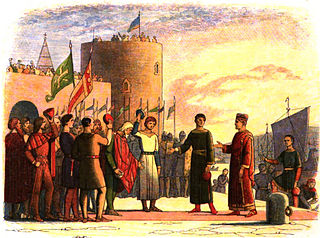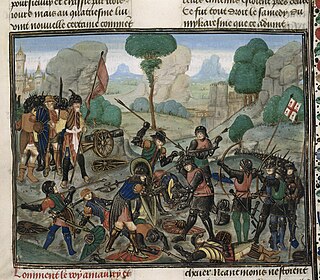
Amalric, formerly known in historiography as Amalric I, was the king of Jerusalem from 1163 until his death. He was, in the opinion of his Muslim adversaries, the bravest and cleverest of the crusader kings.

Salah ad-Din Yusuf ibn Ayyub, commonly known as Saladin, was the founder of the Ayyubid dynasty. Hailing from a Kurdish family, he was the first sultan of both Egypt and Syria. An important figure of the Third Crusade, he spearheaded the Muslim military effort against the Crusader states in the Levant. At the height of his power, the Ayyubid realm spanned Egypt, Syria, Upper Mesopotamia, the Hejaz, Yemen, and Nubia.
The 1160s was a decade of the Julian Calendar which began on January 1, 1160, and ended on December 31, 1169.
The 1170s was a decade of the Julian Calendar which began on January 1, 1170, and ended on December 31, 1179.

Year 1168 (MCLXVIII) was a leap year starting on Monday of the Julian calendar.

Year 1167 (MCLXVII) was a common year starting on Sunday of the Julian calendar.

Year 1171 (MCLXXI) was a common year starting on Friday of the Julian calendar.

The Zengid or Zangid dynasty, also referred to as the Atabegate of Mosul, Aleppo and Damascus, or the Zengid State was initially an Atabegate of the Seljuk Empire created in 1127. It formed a Turkoman dynasty of Sunni Muslim faith, which ruled parts of the Levant and Upper Mesopotamia, and eventually seized control of Egypt in 1169. In 1174 the Zengid state extended from Tripoli to Hamadan and from Yemen to Sivas. Imad ad-Din Zengi was the first ruler of the dynasty.

Nūr al-Dīn Maḥmūd Zengī, commonly known as Nur ad-Din, was a Turkoman member of the Zengid dynasty, who ruled the Syrian province of the Seljuk Empire. He reigned from 1146 to 1174. He is regarded as an important figure of the Second Crusade.

Asad ad-Dīn Shīrkūh bin Shādhī, also known as Shirkuh, or Şêrko was a Kurdish Mercenary commander in service of the Zengid dynasty, then the Fatimid Caliphate and uncle of Saladin. His military and diplomatic efforts in Egypt were a key factor in establishing the Ayyubid dynasty in that country.

The Battle of al-Babein took place on March 18, 1167, during the third Crusader invasion of Egypt. King Amalric I of Jerusalem, and a Zengid army under Shirkuh, both hoped to take the control of Egypt over from the Fatimid Caliphate. Saladin served as Shirkuh’s highest-ranking officer in the battle. This war is Shirkuh's tactic made him win. Accordingly, the army remained at headquarters until the allied forces arrived. Shirkuh concentrated his work in the center and left Saladin Ayyubî here. To the shîrkûh army; "The Egyptian and Crusader forces will think that I am in the center and will attack with all their might. Do not engage them seriously when they attack you. Don't risk yourself by going to war, stay out of their way. When they leave you, follow them immediately. He gave his order. Shirkûh then placed the stronger men of his men on the right flank. When the war finally began, the allies attacked the center. After a small conflict, Saladin and the soldiers under his command deceived the Crusaders and retreated in an orderly manner. This pursuit of retreat by the Crusaders brought their end. Because in the meantime, Shirkuh and his entourage defeated those who remained behind. Those in the middle follow the Muslim Soldiers. When the Crusaders returned, they found their soldiers dead and were defeated. they had to retreat
Abū Muḥammad ʿAbd Allāh ibn Yūsuf ibn al-Ḥāfiẓ, better known by his regnal name al-ʿĀḍid li-Dīn Allāh, was the fourteenth and last caliph of the Fatimid dynasty, and the twenty-fourth imam of the Hafizi Isma'ili branch of Shi'a Islam, reigning from 1160 to 1171.
Shawar ibn Mujir al-Sa'di was an Arab de facto ruler of Fatimid Egypt, as its vizier, from December 1162 until his assassination in 1169 by the Kurdish general Shirkuh, the uncle of the future Ayyubid leader Saladin, with whom he was engaged in a three-way power struggle against the Crusader Amalric I of Jerusalem. Shawar was notorious for continually switching alliances, allying first with one side, and then the other, and even ordering the burning of his own capital city, Fustat, just so that the enemy could not have it.

Egypt was repeatedly invaded from 1163 to 1169 by King Amalric of Jerusalem, who wished to strengthen its position in the Levant by taking advantage of the weakness of the Fatimid Caliphate.
Saladin arrived in Egypt in 1163 and ruled it from 1171 until his death in 1193. Egypt was in a state of decay prior to Saladin's rise to power with the political and social situation in shambles. Saladin first arrived in Egypt alongside his uncle Shirkuh on a campaign launched by Nur al-Din. He would rise to prominence under Shirkuh eventually succeeding him as vizier of Egypt. When the Fatimid Caliphate fell in 1171, Saladin was the only remaining authority in Egypt, he would use his increased power and independence to expand his realm and influence.

In the Battle of al-Buqaia in 1163, the Crusaders and their allies inflicted a rare defeat on Nur ad-Din Zangi, the Emir of Aleppo and Damascus. King Amalric I led the army of the Kingdom of Jerusalem, together with contingents from the northern Latin states, a substantial body of pilgrims who had just arrived from France, and a force brought by the Byzantine governor of Cilicia. For the Christian forces, this victory only gave a brief respite from the sustained Muslim offensive.

The timeline of the Kingdom of Jerusalem presents important events in the history of the Kingdom of Jerusalem—a Crusader state in modern day Israel and Jordan—in chronological order. The kingdom was established after the First Crusade in 1099. Its first ruler Godfrey of Bouillon did not take the title of king and swore fealty to the Latin Patriarch of Jerusalem, Daimbert. Godfrey's brother and successor Baldwin I was crowned the first king of Jerusalem without doing homage to the patriarch in 1100. By 1153, Baldwin I and his successors captured all towns on the Palestinian coast with the support of Pisan, Genoese and Venetian fleets and also took control of the caravan routes between Egypt and Syria. The kings regularly administered other crusader states—the Counties of Edessa and Tripoli and the Principality of Antioch—on behalf of their absent or underage rulers.
Najm al-Dīn Umāra al-Ḥakamī al-Yamanī was a Sunni historian, jurist and poet of Yemen of great repute who was closely associated with the late Fatimid Caliphate of Egypt. He was executed by order of Saladin at Cairo on April 6, 1174 for his part in a conspiracy to restore Fatimid rule. His Tarikh al-Yaman is the earliest, and in respects the most important, history of Yemen from the Islamic era.
Abu'l-Ashbāl al-Ḍirghām ibn ʿĀmir ibn Sawwār al-Lukhamī was an Arab military commander in the service of the Fatimid Caliphate. An excellent warrior and model cavalier, he rose to higher command and scored some successes against the Kingdom of Jerusalem as well as against internal rebellions. Despite his close personal ties to the viziers Tala'i ibn Ruzzik and his son Ruzzik ibn Tala'i, he joined Shawar when the latter rebelled against Ruzzik and seized the vizierate. Nine months later, Dirgham betrayed Shawar as well and expelled him from the capital, becoming vizier himself on 31 August 1163. Amidst yet another Crusader invasion in 1164, Dirgham clashed with Shawar, who had gained the support of Syrian troops led by Shirkuh. Deserted by most of his troops, Dirgham was killed sometime in May–August 1164 by Shawar's army.

In 1173–1174, a conspiracy took place in Cairo in favour of restoring the Isma'ili Shi'a Fatimid Caliphate, which had been abolished in 1171 by Saladin, the first Ayyubid ruler of Egypt. The conspiracy, which is known only from sources favourable to Saladin, was led by elites of the fallen Fatimid regime, and aimed to seize control over Cairo by taking advantage of Saladin's absence from the city on campaign. To this end, they are alleged to have contacted the Crusaders of the Kingdom of Jerusalem, inviting them to invade Egypt in order to lure Saladin away. The conspirators are also said to have contacted the Nizari Isma'ili Order of Assassins to assassinate Saladin. The veracity of these claims is disputed by modern historians, who consider them inventions aimed to discredit the conspirators. In the event, the conspiracy was betrayed to Saladin, although the sources differ on how exactly. Some even hold that the conspiracy was precipitated by Saladin as a political purge, or as a means of demonstrating to his increasingly hostile nominal master, the emir of Aleppo and Damascus, Nur al-Din Zengi, that Egypt was still unruly and that Saladin was indispensable to keep the opposition in check. The Ayyubid ruler struck on 31 March 1174 and arrested the ringleaders, among them the celebrated poet Umara al-Yamani. The chief conspirators were executed at the Bayn al-Qasrayn square from 6 April until 23 May, while others were exiled. A pro-Fatimid revolt in Upper Egypt followed, but was suppressed in September by Saladin's brother, al-Adil.












